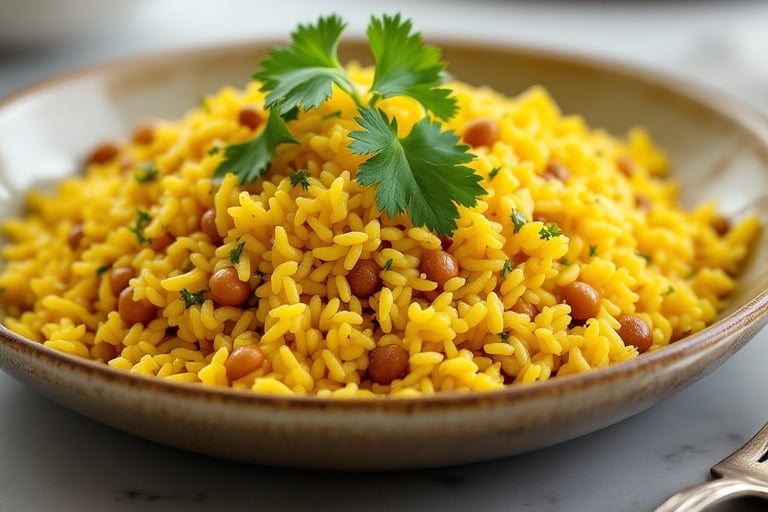Rice with Pigeon Peas
Rice with Pigeon Peas (known as Arroz con Gandules) is one of the staple dishes from Puerto Rico. It is a classic and flavorful dish that is often served at holiday gatherings, family meals, or special occasions. It is rich in flavor, thanks to the use of sofrito, annatto oil, and other seasonings.
RICEVEGETARIANGLUTEN FREE
Lourdes Rodríguez
3/1/20254 min read
Rice with Pigeon Peas is a Cultural Heritage of Puerto Rico
Arroz con Gandules, or rice with pigeon peas, is a quintessential dish that encapsulates the rich cultural heritage of Puerto Rico. This vibrant meal is not merely a staple on Puerto Rican dining tables; it is a symbol of family connection, celebratory gatherings, and communal ties. Often prepared during holidays, weddings, and various festivities, Arroz con Gandules brings friends and families together, reinforcing the importance of unity in Puerto Rican culture.
The origins of this dish can be traced back to the indigenous Taíno people and the African and Spanish influences that shaped Puerto Rican cuisine. The incorporation of pigeon peas, legumes rich in nutrients, has made this dish both a flavorful and healthy option for families. Arroz con Gandules is colorful and aromatic dish that is as pleasing to the eye as it is to the palate.
The cooking technique often involves the use of sofrito, a foundational blend of garlic, onions, peppers, and herbs, which infuses the rice with unparalleled depth of flavor. Each family adds their unique touch to the recipe, ensuring that every serving of Arroz con Gandules is distinct, yet familiar. This personalizes the dish and makes it a cherished tradition passed through generations, reflecting both love and creativity in its preparation.
Beyond its delightful taste, Arroz con Gandules is a potent reminder of the importance of preserving cultural identity through cuisine. It also serves as a means for Puerto Ricans to share their cultural narrative with others, making this dish a symbol of pride and tradition in Puerto Rico.
Health Benefits and Nutritional Information
Pigeon peas, a crucial ingredient in the traditional Puerto Rican dish of Rice with Green Pigeon Peas, are renowned for their impressive nutritional profile. Rich in protein, these legumes provide approximately 8 grams of protein per cooked half-cup serving, making them an excellent source for vegetarians and those looking to increase their protein intake without consuming excessive amounts of meat. Additionally, pigeon peas are packed with dietary fiber, which aids in digestion and helps regulate blood sugar levels. This makes them an ideal food choice for individuals managing diabetes or seeking to maintain stable energy levels throughout their day.
The inclusion of rice in this dish complements the nutritional benefits while offering carbohydrates that are essential for energy. Whole grain varieties of rice, such as brown rice, can further enhance the healthfulness of this meal by adding additional fiber and essential nutrients like B vitamins and magnesium. When prepared in conjunction with spices such as garlic, oregano, and bell peppers, the flavor profile is not only elevated but also provides additional health advantages. Garlic is noted for its immune-boosting properties, while bell peppers are rich in vitamins A and C, contributing to overall well-being.
Incorporating nutrient-rich, home-cooked meals like Rice with Green Pigeon Peas into a balanced diet is vital for maintaining a healthy lifestyle. Home-cooked meals generally contain fewer preservatives and unhealthy fats that are often present in processed foods. Preparing this dish allows individuals to control the ingredients and their quantities, leading to healthier eating habits. Consequently, embracing traditional recipes that celebrate local ingredients can be both a flavorful and rewarding experience for individuals seeking health improvement and culinary richness.
Rice with Pigeon Peas
Yield: 2-3 servings
Cook time: 30 minutes
Ingredients:
A: 1 cup medium grain rice
1/2 cup of precooked pigeon peas
2 Tbsp. olive oil
1 Tbsp. sofrito
1 Tbsp. tomato paste
1/2 to 1 envelope of ham or chicken bouillon
1/2 to 1 envelope of annatto seasoning
1 Tbsp. green olives
1 tsp. dried oregano
B: 1 cup of water
Instructions:
In a saucepan heated over medium heat add the ingredients from section A, mix the ingredients for one to two minutes.
Add the ingredient in section B, cook the rice uncovered over medium heat until the liquid is 90% absorbed.
Then, reduce the heat to low and cover the pot with a tight lid, cook the rice for 15 minutes.
Uncover the pot and fold the rice. Cover with the lid and let the rice cook for 10 minutes over low heat. Serve!
Note:
If you want to substitute the medium rice grain here are the ratios:
Long grain rice 1 serving of rice for 1 1/2 of liquid. (1: 1 ½)
Brown rice 1 serving of rice for 2 of liquid. (1:2)
The ingredients can be easily found on the International/Latin aisle in most grocery stores.
Here are some great suggestions on how to serve this delicious dish:
Vegeterian: Arroz con Gandules can be a satisfying main dish on its own, especially if you're serving it with a fresh salad.
Grilled or Roasted Meat: Serve alongside grilled chicken, pork (like pernil), or steak. The hearty and savory flavors of the rice complement the richness of the meats.
Baked of Fried Fish: If you're in the mood for something lighter, serve it with baked fish or fried fish which offers a crispy contrast.
Holiday Meals: Serve as a side dish with traditional Puerto Rican lechón (roast pork), alongside pastelón (a Puerto Rican-style lasagna made with plantains) or pasteles (a traditional Puerto Rican dish that are often compared to tamales).
Reasons to Limit or Avoid Rice and Pigeon Peas:
High Carb Content (for Diabetics or Low-Carb Diets): Rice is high in carbohydrates, which can cause spikes in blood sugar levels. For individuals with diabetes or those following a low-carb diet, consuming rice may not be ideal. The carbs from rice are quickly absorbed into the bloodstream, which can affect blood glucose levels. If you are looking to reduce carbs, swap regular white rice for brown rice, which has a lower glycemic index and more fiber.
Pigeon Peas and Digestive Sensitivity: While pigeon peas are rich in protein and fiber, they may cause digestive discomfort for people with sensitive stomachs, such as those with irritable bowel syndrome (IBS) or other gastrointestinal issues. The fiber in pigeon peas can lead to bloating, gas, or other symptoms if consumed in large amounts.
Kidney Issues: Individuals with kidney disease should limit foods high in potassium and phosphorus. Pigeon peas are a good source of both, and while rice is lower in these nutrients, the combination may still be problematic for individuals on a renal diet. Consuming large quantities of these foods may place additional strain on the kidneys.
Important: If you have any doubts about incorporating this food into your diet, it is always a good idea to consult with your dietitian or doctor.


Plenitaste
Inspiring healthy, global recipes for everyone.
contact me:
Recipe
plenitaste@gmail.com
© 2025. All rights reserved.
